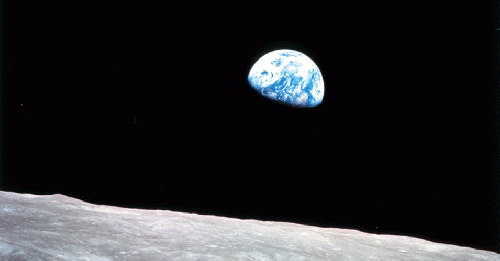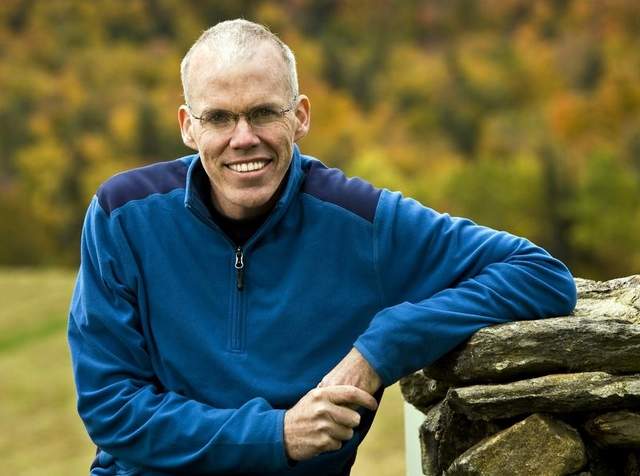From Common Dreams
"At least on a human timescale, we'll never have a planet as intact and full of life as that one we glimpsed from space. Our trajectory is definitely downward. But there was so, so much beauty there, and there's still so much left -- for now."

Of the 1968 photograph, Apollo 8 Commander Mark Borman later described it 'the most beautiful, heart-catching sight of my life, one that sent a torrent of nostalgia, of sheer homesickness, surging through me. It was the only thing in space that had any co
(Image by (Photo: NASA)) Details DMCA
1968 was a crazy year, its events moving at a horrific pace. The Tet Offensive. The My Lai Massacre. Bobby Kennedy announcing the news that the Rev. Martin Luther King Jr. had been assassinated. Bobby Kennedy's assassination. Riots across urban America and outside the Democratic National Convention. The human drama seemed out of control in a way it hasn't in the years since -- till now, of course.
Which is why it's both heartening and sad to think of the event that brought 1968 to a close and opened a new set of possibilities. Apollo 8 was orbiting the moon, its astronauts busy photographing landing zones for future missions. On the fourth orbit, Commander Frank Borman needed a navigational fix and decided to roll the craft away from the moon, tilting its windows toward the horizon. The shift gave him a sudden view of the Earth rising.
"Oh, my God," he said. "Here's the Earth coming up."
Crew member Bill Anders turned the camera away from its lunar chores and pointed it homeward, snapping what may be the most iconic image ever taken. Borman said later that it was "the most beautiful, heart-catching sight of my life, one that sent a torrent of nostalgia, of sheer homesickness, surging through me. It was the only thing in space that had any color to it. Everything else was simply black or white. But not the Earth."
Back on Earth, the seeds of the modern environmental movement had already been planted. Rachel Carson had written Silent Spring earlier in the decade, beginning the process of wiping some of the shine off modernity. David Brower had led the Sierra Club through the great fight to save the Grand Canyon, turning it in the process into the first great green group. And soon there would be a major oil spill off the coast of Santa Barbara, and the Cuyahoga River would burst into flames. People were beginning to realize that there were limits to the abuse nature could take at the hands of growth.
But suddenly those limits were visible. Everything we had was there before us: a blue-and-white shimmering egg hanging in the monochrome void. You could see it aswirl with the motion of clouds, gloriously alive in the midst of the endless vacuum.
When we think of the Apollo missions, we often herald NASA's accomplishments as technical. We put a man in orbit, and then we landed more on the moon. And yet one of the most important achievements of the decades of space exploration was artistic -- this one photograph taken 50 years ago this month that showed us nothing about the rest of the galaxy and everything about our home.
It explained, I think, the tenor of the first Earth Day, which followed about 15 months later. Organized as a "national environmental teach-in" by Democratic Sen. Gaylord Nelson and Republican Rep. Pete McCloskey, the day used an image of Earth from space as its unofficial flag. The event drew 20 million Americans into the streets -- a tenth of the population at the time, probably the largest day of political action in American history.
Though it emerged from the fraught and divisive politics of the late 1960s, there was a sweetness to Earth Day. The event had a sense of unity because -- and this was the point made so clear in the Earthrise image -- we were clearly all in it together.
"Earth Day is the first holy day which transcends all national borders, yet preserves all geographical integrities, spans mountains and oceans and time belts, and yet brings people all over the world into one resonating accord, is devoted to the preservation of the harmony in nature and yet draws upon the triumphs of technology, the measurement of time, and instantaneous communication through space," wrote Margaret Mead.
The effect of that unity was startling. Within the next few years, the Environmental Protection Agency was created and the Clean Water and Endangered Species acts were signed into law by President Richard Nixon, a man who lacked a scintilla of environmental awareness or interest but who responded to the movement overtaking Washington at the time.
That burst of legislation, emulated around the planet, was a remarkable recognition that we needed to control ourselves if we were to preserve that lonely, lovely sphere floating in the darkness.
"Limits to Growth," a 1972 treatise based on simple computer models that flagged our fast-approaching planetary boundaries, was an attempt at a troubleshooting guide for what we'd begun to call "Spaceship Earth." The Whole Earth Catalog, with a picture of the Earth from space on its cover, was the hippie-ish operating manual. For a while, it looked as if it all might take: By 1978, a decade after Apollo 8 returned to terra firma, pollsters reported that 30 percent of Americans were "pro-growth," 31 percent were "anti-growth," and 39 percent were "highly uncertain." We almost built a new world.
(Note: You can view every article as one long page if you sign up as an Advocate Member, or higher).





